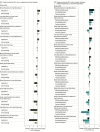Associations of Changes in Sleep and Emotional and Behavioral Problems From Late Childhood to Early Adolescence
- PMID: 37017952
- PMCID: PMC10077137
- DOI: 10.1001/jamapsychiatry.2023.0379
Associations of Changes in Sleep and Emotional and Behavioral Problems From Late Childhood to Early Adolescence
Abstract
Importance: Sleep problems and psychopathology symptoms are highly comorbid and bidirectionally correlated across childhood and adolescence. Whether these associations are specific to discrete profiles of sleep problems and specific internalizing and externalizing phenomena is currently unclear.
Objective: To characterize individual changes in profiles of sleep problems and their prospective associations with psychopathology symptoms across the transition from childhood to adolescence.
Design, setting, and participants: This observational cohort study used baseline data (participant age of 9 to 11 years) and 2-year follow-up data (participant age of 11 to 13 years) from the community-setting, multicenter Adolescent Brain Cognitive Development (ABCD) study. Individuals were assessed for a range of sleep problems at both waves and categorized into profiles via latent profile analysis. The stability and change in these profiles over time was assessed via latent transition analysis. Logistic regression models examined whether psychopathology symptoms were cross-sectionally associated with profile membership and whether transitions between profiles were associated with changes psychopathology symptoms over time. Data were collected from September 2016 to January 2020, and data were analyzed from August 2021 to July 2022.
Exposures: Sleep problems were assessed at both baseline and follow-up via the parent-reported Sleep Disturbance Scale for Children (SDSC).
Main outcomes and measures: Psychopathology symptoms at both baseline and follow-up were assessed using the internalizing and externalizing dimension scores derived from the parent-reported Child Behavior Checklist.
Results: A total of 10 313 individuals (4913 [47.6%] were female) were categorized into 4 latent profiles of sleep problems at both baseline and follow-up: a low disturbance profile, a sleep onset/maintenance problems profile, a moderate and nonspecific disturbance profile (termed mixed disturbance), and a high disturbance profile. Individuals in the 3 more severe problem profiles displayed greater risk of concurrent internalizing symptoms (sleep onset/maintenance problems: odds ratio [OR], 1.30; 95% CI, 1.25-1.35; P < .001; mixed disturbance: OR, 1.29; 95% CI, 1.25-1.33; P < .001; high disturbance: OR, 1.44; 95% CI, 1.40-1.49; P < .001) and externalizing symptoms (sleep onset/maintenance problems: OR, 1.20; 95% CI, 1.16-1.23; P < .001; mixed disturbance: OR, 1.17; 95% CI, 1.14-1.20; P < .001; high disturbance: OR, 1.24; 95% CI, 1.21-1.28; P < .001). Transitions between sleep profiles over time were associated with prospective internalizing and externalizing symptoms, but not vice versa.
Conclusions and relevance: There are substantial changes in sleep problems across the transition to adolescence that are associated with later internalizing and externalizing symptoms. Sleep profiles could be targeted in future intervention and treatment programs to improve sleep-related and mental health-related outcomes across development.
Conflict of interest statement
Figures




References
Publication types
MeSH terms
Grants and funding
- U01 DA041048/DA/NIDA NIH HHS/United States
- U01 DA050989/DA/NIDA NIH HHS/United States
- U01 DA051016/DA/NIDA NIH HHS/United States
- U01 DA041022/DA/NIDA NIH HHS/United States
- U01 DA051018/DA/NIDA NIH HHS/United States
- U01 DA051037/DA/NIDA NIH HHS/United States
- U01 DA050987/DA/NIDA NIH HHS/United States
- U01 DA041174/DA/NIDA NIH HHS/United States
- U01 DA041106/DA/NIDA NIH HHS/United States
- U01 DA041117/DA/NIDA NIH HHS/United States
- U01 DA041028/DA/NIDA NIH HHS/United States
- U01 DA041134/DA/NIDA NIH HHS/United States
- U01 DA050988/DA/NIDA NIH HHS/United States
- U01 DA051039/DA/NIDA NIH HHS/United States
- U01 DA041156/DA/NIDA NIH HHS/United States
- U01 DA041025/DA/NIDA NIH HHS/United States
- U01 DA041120/DA/NIDA NIH HHS/United States
- U01 DA051038/DA/NIDA NIH HHS/United States
- U01 DA041148/DA/NIDA NIH HHS/United States
- U01 DA041093/DA/NIDA NIH HHS/United States
- U01 DA041089/DA/NIDA NIH HHS/United States
- U24 DA041123/DA/NIDA NIH HHS/United States
- U24 DA041147/DA/NIDA NIH HHS/United States
LinkOut - more resources
Full Text Sources
Medical

